A CONSPECTUS OF THE LICHEN GENUS STEREOCAULON ...
A CONSPECTUS OF THE LICHEN GENUS STEREOCAULON ...
A CONSPECTUS OF THE LICHEN GENUS STEREOCAULON ...
Create successful ePaper yourself
Turn your PDF publications into a flip-book with our unique Google optimized e-Paper software.
I. MACKENZIE LAMB: A Conspectus of Stereocaulon 325<br />
Typus: Finland, Hollola, Hayhto, on rock, leg. E. LANG (VAINIO), 1874 (H-NYL, no. 39967, holotypus).<br />
Obviously belongs to the paschale-saxatile group, but is peculiar in its copious fertility,<br />
with numerous minute apothecia, and its quite glabrous pseudopodetia. Phyllocladia PD-.<br />
We could not see any affinity with St. subcoralloides (NYL.) NYL., to which NYLANDER<br />
relates it. FREY also saw the type specimen, and gives some anatomical details (1932, p. 116).<br />
Although several specimens from Europe and N. America have been seen which correspond<br />
more or less to it, we cannot be sure of the identity, and prefer to consider St. subintricans as a<br />
doubtful species.<br />
St. tenuissimum DEL.<br />
ex NYL. Synopsis Methodica Lichenum, 1 (2): 242 (1860).<br />
Published by NYLANDER under St. coralloides FR., as "forma videtur sterilis transiens<br />
fere in Ster. Delisei. Cephalodia illius tenuissimi interdum cinereo-olivacea", from France,<br />
Dept. Calvados, St. Sever near Vire. The specimen not seen by us, and its identity doubtful.<br />
St. tomentosum f. jlabelliforme OHL.<br />
Schr. Konigl. ~hys.-bkon. Ges. Konigsberg, 11: 8 (1870).<br />
3 localities in former E. Prussia (now Poland) mentioned (Oletzo, Angerburg, Neustadt),<br />
no holotype designated. We have not seen any of the type material,86 nor apparently did<br />
FREY, who from the description equates it with typical St. tomentosum (1932, p. 184).<br />
OHLERT describes it as flabellately expanded with the phyllocladia forming a continuous crust<br />
on the upper side, and the pseudopodetia glabrous on the underside. The latter feature does<br />
not conform to St. tomentosum, and the f. flabelliforme, until the type material is found, must<br />
be regarded as a doubtful taxon.<br />
St. tomentosum var. hercynicum FREY<br />
Rabenhorsts Krypt.-Fl. 9, Abt. IV, 1. Halfte: 187 (1932).<br />
Typus: Germany, Harz, Lautenberg in Lutter Valley, leg. ZSCHACKE (date?), destroyed<br />
with ZSCHACKE'S herbarium (B) in World War 11, and not seen by us. From FREY'S description<br />
it seems to be probably synonymous with St. tomentosum var. compactum FREY.<br />
St. tomentosum f. leptothamnium FREY<br />
Rabenhorsts Krypt.-FI. 9, Abt. IV, 1. Halfte: 185 (1932).<br />
Typus: Poland (formerly Schlesien), Hartau, probably near Katzengebirge, leg. FLOTOW<br />
(date?), destroyed with FLOTOW'S herbarium (B) in World War 11, and not seen by us. From<br />
FREY'S description it appears to be a non-taxonomic modification of St. tomentosum, but<br />
its status remains doubtful.<br />
St. tomentosum f. walamoense NYL.<br />
Synopsis Methodica Lichenum, 1 (2): 244 (1860). -St. tomentosum var. walamoCnse (Nn.) Nn.<br />
Lichenes Scandinaviae: 65 (1861). - Stereocaulon valamoCnse [sic] (NYL.) RAS. Meddeland. Soc. Fauna<br />
Fl. Fenn. 50: 39 (1925). -St. alpinum f. walamoCnse (NYL.) FREY, Rabenhorsts Krypt.-FI. 9, Abt. IV,<br />
1. Halfte: 164 (1932).<br />
Typus: U.S.S.R., Karelia ladogensis, Valarno Island in Lake Ladoga, "supra terram nudam aridissimam",<br />
leg. W. NYLANDER, 1851 (H-NYL, no. 39952, holotypus; PC, isotypus).<br />
A very minute and poor specimen, resembling a much depauperated condition of St.<br />
s6 OHLERT'S herbarium is reputed to be at the University of Konigsberg (now Kaliningrad).

















